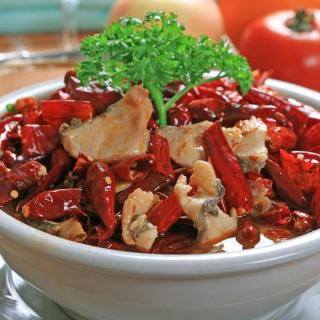
介绍:
完整文稿请关注我们10月1日的微信:英语环球 NEWSPlus
Known within China as "the Heavenly State," the southwestern province of Sichuan is famous for its natural beauty, cultural attractions, endangered pandas and delicious foods. It is said that with Sichuan cuisine, "each dish has its own flavor and a hundred dishes have a hundred flavors." Sichuan's culinary traditions date back more than 2000 years. In the centuries that followed, its cooking styles and flavors absorbed different schools of cooking and developed into today's Sichuan cuisine, one of the eight great regional cuisines of China. Our reporter Zhou He-yang has more.
In Sichuan, each mouthful of food is a bite of history and culture. The iconic flavors of this region -- the searing hot chilies, numbing Sichuan peppercorns and aromatic garlic of its home-style foods, as well as its refined banquet dishes -- are all regarded by China's gastronomes as signatures of one of the country's greatest cuisines.
The basic principles of the cuisine were developed at the end of the Qin Dynasty more than 2000 years ago; and over the following centuries its flavors were further influenced by immigrants.
This southwestern province was a meeting place for traders, noblemen and common settlers from around the country, and their regional taste and cooking influences came with them. Later these merged into the fusion cuisine that changed the flavors of Sichuan forever.
Traces of this culinary heritage are still evident in Sichuan cooking, in the robust flavors of Hunan and the refined cooking of Guangdong, the delicate fish dishes from the fertile river valleys to the east, and the hearty noodles and beef dishes that still grace the tables of nomads and farmers from China's vast northern prairie.
But today's Sichuan cuisine is much better known for its intense, spicy flavors, provided by the liberal use of chilli peppers, numbing Sichuan peppercorns, bean paste and garlic. Peppercorns and garlic have long held sway in many of China's regional dishes, but chili peppers were the upstarts that so overhauled Sichuan's cuisine.
The tradition of adding spice to food to warm up Sichuan residents began at least two millennia ago. In the mountain-locked region, where the air is damp and the skies often overcast, this fiery hotness is believed to rid the body of internal dampness and overcome the cold.
At the very beginning, the locally grown peppercorn ingredient provided the essential spice, but when chili peppers were introduced to the country, everything changed.
Sichuan-native and food writer Shi Guanghua explains:
"If chili hadn't been introduced to the local cuisine, peppercorns might have quit their role as a cooking ingredient in Sichuan. It is the miraculous combination of chili and peppercorns that brings out the spicy flavor of Sichuan cuisine. The world of flavor has since opened up for the spice-addict Sichuan residents, who believe in embracing anything that tickles their taste buds."
The peppercorn is a native Sichuan spice. Huajiao in Chinese, it's made from the dried outer casings of Chinese prickly ash berries. Its flavor has slightly lemony overtones and it creates a numbing sensation in the mouth. Before chili peppers were introduced to China at the end of the 17th century, peppercorns were the signature ingredient of Sichuan cuisine.
Originating in South America, the hot pepper arrived in Sichuan as the Europeans discovered America and commerce developed. The ingredient soon became a mainstay in local recipes and is seen nowadays as the cuisine's trademark. Only then did Sichuan dishes start using red hot oils, crispy dried chilies, and fresh peppers to add that herbal zing.
In the eyes of Shi Guanghua, the union of the Sichuan peppercorn and the imported chili peppers is like a chemical love story.
"Sichuan peppercorns are best combined with chili peppers. Chilies burn, while Sichuan peppercorns tingle and ginger adds "zing". It is all very interesting and enticing. At the same time, the numbness that peppercorns bring lessens the heat of the chili, allowing diners to taste and appreciate other flavors in the dish."
The combination has become a symbol of the local cuisine - famed the world over for its sharp and furious kicks on the palate, threatening to set one's mouth on fire.
But a good Sichuan meal is not all hot; it's balanced. There is a traditional saying that refers to the local cuisine--"Yicaiyige baicaibaiwei", which means each dish has its own style; a hundred dishes have a hundred different flavors. Here is Shi Guanghua again.
"It's a misconception to label Sichuan food as simply spicy. In fact, it offers a "bouquet of flavors" with gradations of spice combined with other tastes, such as sweet and sour and ginger juice. A Sichuan banquet should have constant stimulation and excitement. You have something hot and then something soothing, then you have a light soup, then something sweet...variety is the spice of life."
Sichuan cuisine is highly subtle and sophisticated. There are 23 different discernable flavors, divided into four categories based on whether they are salty, spicy, sweet or sour. More than 20 techniques are used-- indeed, there are different ways to simply fry.
Liu, for example, means to take an ingredient, which usually has some starch paste on it, and pre-cook it in oil. Then a sauce is made and the two mixed together. 'Bian' means to basically stir-fry. 'Ganbian', meaning dry bian, means to fry without oil until later, when seasoning is added. 'Qiang' is frying Sichuan pepper and chili and then adding an ingredient to drive in the spice.
In places that have very serious cultures of gastronomy, cooking has to be very systematic.
大家还在听

